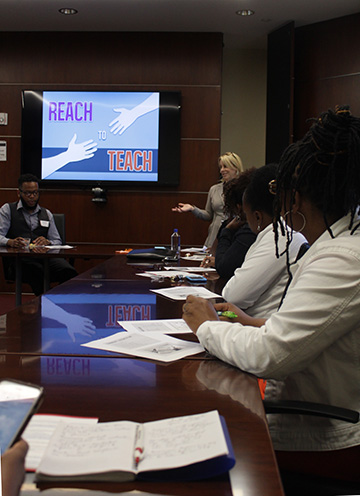
More than 120 superintendents, principals and teachers throughout Alabama attended the May 2 conference, “Neuroscience of Learning: A Follow Up to the Finland Summit,” presented by Orlean Beeson School of Education in partnership with the Goodrich Foundation. Attendees represented more than 20 school districts as well as several private schools, Alabama State Department of Education and Alabama Department of Public Health.
According to David Finn, Samford professor and member of the event’s planning committee, the goal of the conference was to continue the conversation about factors that positively impact student achievement. “The philosophy and practice of educational neuroscience embraces those factors, and has caused contemporary educators to consider ways of incorporating those principles into the daily lives of all children,” said Finn.
In the interactive morning session, Lori Desautels, assistant professor at Butler University, shared her passion for engaging students through neuroscience in education. She integrates mind brain teaching and learning strategies into her courses.
Desautels asked participants to place one hand on either side of their head and connect their pointer finger and thumb to make a circle around their temple. “This is your amygdala; this is the place that holds emotion,” said Desautels. “When a student enters your classroom wired up or shut down, oxygenated blood flow is going to this area, thus decreasing the blood flow to the frontal lobe.”
The frontal lobe’s function includes problem solving, spontaneity, memory, language, initiation, impulse control and social behavior. According to Desautels, these are skills necessary for a child to learn in the classroom. Instead of asking, “What is wrong with this student?” Desautels encouraged teachers to ask, “What happened to this student? What is the story of this student?”
Desautels said it is crucial for educators to provide students with all the tools they need to learn in the classroom. Those tools can be better identified when there is an understanding of what the brain needs to learn.
Attendees participated in breakout sessions were based on one of seven key points identified in the fall 2016 Finland Summit conference. In one session, participants discussed the need for movement in the classroom.
“Keep your students engaged and ready to learn through what I call brain breaks,” said session facilitator Chelsea Byrd, a teacher in Jasper City Schools. She showed a video that used a dance and rap to explain the water cycle from a website that holds hundreds of videos created to activate students’ bodies and brains.
April Brand from Helena High School led School Based Time—Pack 60. “Pack 60 was instituted to provide students with a break from academics through a variety of scheduled options during their lunch period,” said Brand. Students are given 30 minutes to eat and 30 minutes to meet with extracurricular clubs and to build student relationships.
Superintendent of Fairfield City Schools Walter Gonsoulin believes in the importance of students having basic needs met in order to learn. “We want to remove barriers to student success by helping students and families access comprehensive wrap-around services,” said Gonsoulin. “These services include, but are not limited to, primary health, dental care, vision care and mental health care.” The services are offered at or near the school site.
In addition to her conference presentations, Desautels met with Orlean Beeson School of Education undergraduate and graduate students in the afternoon. “I am so excited to share a couple of things that I wish so desperately someone had shared with me when I was a new teacher,” said Desautels.
Desautels then asked a Samford student to hold a water bottle high in the air while she continued her lecture. A few minutes later, Desautels asked the student how she was doing. “That was tough. My arm hurts,” replied the student. Desautels asked her how she felt her listening was affected by holding the water bottle. The student laughed and said, “Oh, I don’t know that I heard a word you said. I was so focused on my arm.”
Desautels explained that this is what happens to students when they walk into a classroom with baggage or a weight over their heads. Students often shut down and are unable to learn.
Students and conference participants were asked to remember three key points. First, neuroplasticity is the brain’s ability to form and reorganize synaptic connections in response to learning or experience. Second, students respond to someone they feel cares and is someone they respect. Third, teach and model the behaviors they want to see. “Think of teaching behavior like you would think of teaching someone to ride a bike,” said Desautels. “Don’t punish; the brain learns from repetition.”
Sara Roman is marketing and communication coordinator for Orlean Beeson School of Education.
